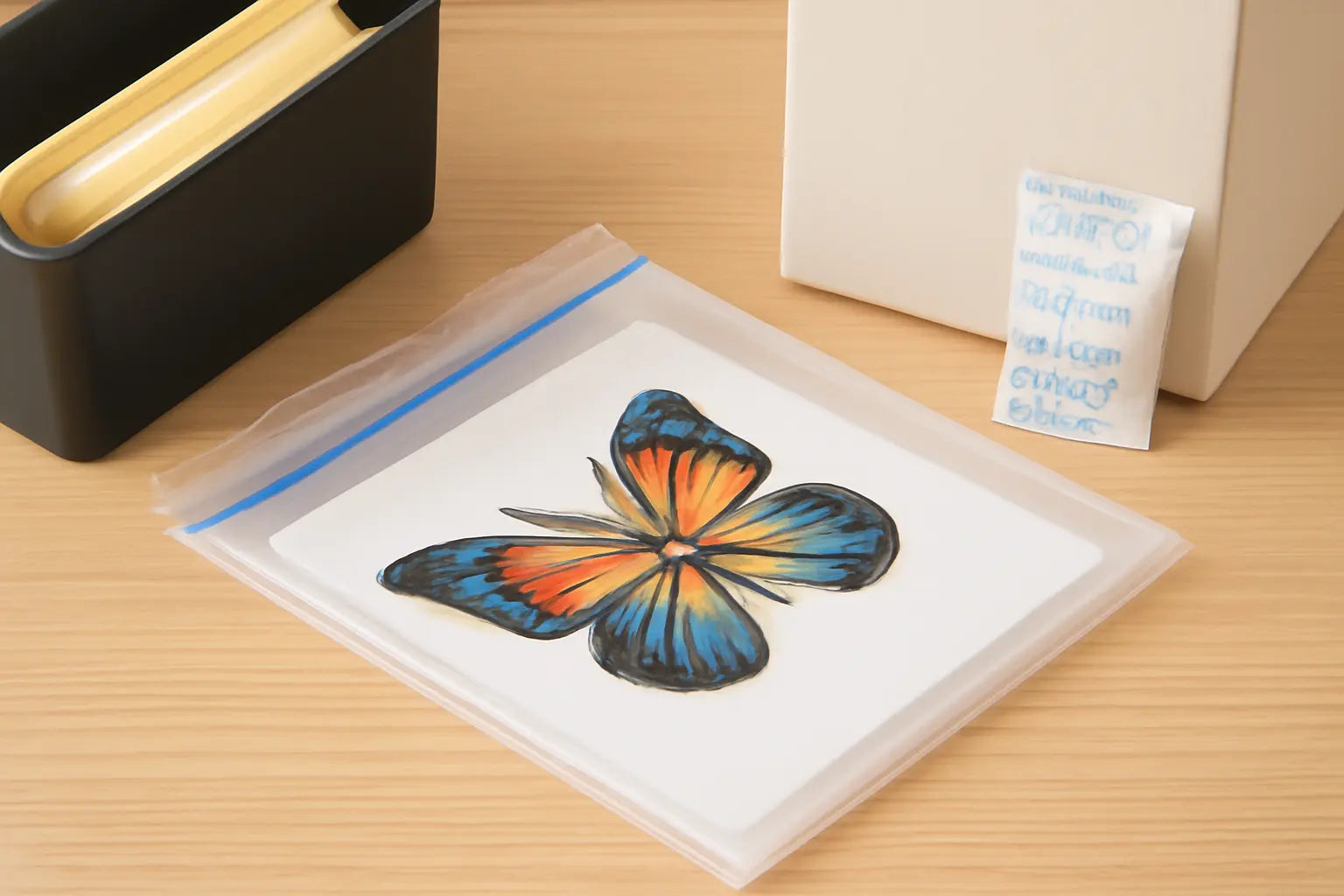DTF printing can increase profitability for any business, regardless of the type. If you're a brand looking to create a lucrative business, DTF could significantly increase your annual revenue. But here’s the thing—if you’re lazy about storing your transfers before pressing, you’re setting yourself up for a severe loss. Proper DTF transfer storage tips can help you prevent unnecessary loss and ensure that your transfers remain in good condition for an extended period.
So, read on to learn how you can prevent inventory loss when using DTF transfers for your merchandise.
Top 10 DTF Transfer Storage Tips for Lasting Durability
We've rounded up the top 10 storage tips to keep your transfers fresh, bold, and looking like new, even after months. This isn’t just an optional step—think of proper storage as the secret sauce for protecting your hard work and ensuring your finished product wows people. Your reputation depends on this, so let’s not
1. Protect Transfers from Light, Dust, and Air
The best way to store DTF transfers is to place each sheet into a plastic sleeve or a resealable bag—using acid-free and archival-grade materials is recommended. If you’re in a humid area, add a silica gel pack to absorb moisture. And avoid PVC plastics—they can mess with your ink over time. Store in opaque folders or envelopes to keep sunlight from fading your colors. Keep DTF transfers dust-free and sealed to avoid scratches and other damage. It takes just five minutes to do, but it’ll save your work.
2. Handle With Clean, Dry Hands
Nobody wants a greasy thumbprint ruining their design. Wash and dry your hands before touching the PET film. If you’re handling them a lot, wear cotton or nitrile gloves. Don’t poke the printed side—your fingerprints could mess with adhesion or leave marks. Grab the sheets by the corners, or use tweezers for greater accuracy. These are basic DTF transfer handling instructions—make it a rule in your shop.
3. Label and Date Everything
If you don’t label your transfers, you’ll end up forgetting prints at the worst possible moment. Mark the PET backing (not the printed area) with a fine-tip marker or sticker, including the date, design, peel type, and client. Use up your old stock first. Wondering how long do DTF transfers last in storage? A properly stored transfer can last several months, but even the best prints degrade over time.
4. Hands Off Unless You’re Pressing
Every time you touch a transfer, there’s a chance of bending, scratching, or smudging. Avoid unnecessary handling. Keep transfers in their protective bags or folders until they’re ready to press. Don’t mix old and new prints. If you’ve got a team, limit who can access it. Less handling means fewer mistakes. This is proper DTF transfer handling 101.
5. Keep Transfers Away From Chemicals
DTF film is surprisingly sensitive to its environment. Keep your transfers far from cleaning sprays, ink solvents, and harsh aerosols. Even air fresheners or scented diffusers can mess with your colors or adhesive. Give your DTF stash its zone. Store them in airtight bins with solid lids if they share space with your printer. That’s how you avoid DTF transfer cracking before you ever hit the press.
6. Do a Quick Inspection Before Pressing
Have you ever pressed a shirt and then noticed a random crease or scratch on the print? Always check your transfer under a good light before using it. Look for curled corners, visible scratches, or issues with the ink. Confirm whether it’s a hot peel or cold peel, as mixing them up can ruin shirts. These tips for preserving DTF transfers are small habits that go a long way.
7. Practice FIFO—First In, First Out
Transfers don’t get better with age. Always use the oldest ones first. Label by date, sort into folders or bins, and consider color-coding if you’ve a large volume. FIFO isn’t just for grocery stores—it’s your best defense against wasted materials. The shelf life of DTF transfers is limited, even when stored properly. Stay organized and cycle through your inventory regularly.
8. Use Storage Systems—Not Piles
Don’t let transfers pile up in boxes or loose stacks. All it takes is one misstep to ruin a batch. Invest in shallow drawers, vertical bins, or hanging folders. Label them by size, order, or peel type. This way, you’re not scrambling mid-shift to find a design. Whether it’s a small shop or a large warehouse, how to store heat transfers means storing them flat and protected.
9. Control the Temperature and Humidity
Heat and moisture are the ultimate enemies. Store your transfers in a cool, dry space. The ideal temperature should be around 65–75°F. Humidity should sit between 40% and 50%. Excessive heat can warp the film, while excessive moisture can cause the adhesive to fail. If you wouldn’t leave your favorite snacks in that room, don’t leave your transfers there either. That’s the best temperature to store DTF transfers with proper humidity for DTF transfer storage to keep them stable.
10. Give Transfers a Real Home
Don’t just toss your transfers into “that one drawer.” Set up a real storage area. Use labeled bins and protective sleeves, spacing them so they don't press into each other. You spent money and time on those prints—they deserve a clean, stable home. Following the manufacturer's DTF transfer handling instructions will keep your shop efficient and your clients impressed.
Why Choose Music City DTF?
If you want vibrant, durable, and consistent results, Music City DTF is the way to go. We use top-tier inks, adhesive powders, and PET films—no shortcuts. You’ll get fast turnaround times, local Nashville craftsmanship (made in the USA), and responsive customer support. Whether you're working on a single custom tee or a bulk order for retail, Music City DTF delivers quality you can count on. Our products are rigorously tested, ensuring lasting color, sharp detail, and smooth application, making them a top-tier choice for anyone serious about garment printing.
Final Thoughts
How to handle DTF transfers the right way isn’t optional—it’s essential. These sheets aren’t just a step in the process; they are the product until you press them. So, if you’ve been letting them gather dust, get scratched up, or hang out in a humid corner of your shop, it’s time to upgrade your habits by following the above-mentioned DTF transfer storage tips.
Label them, store them flat, check them before use, and stop overhandling. Small moves like this can lead to significant savings—fewer ruined shirts, fewer reprints, and more satisfied customers. From knowing the DTF cold peel time to storing at the best temperature to store DTF transfers, it’s all about treating your prints with the respect they deserve.
Ready to start printing? Get started with our DTF sample pack and gang sheet builder to create stunning designs for your merch!





